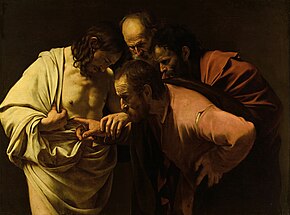
The Adoration of the Magi or Adoration of the Kings or Visitation of the Wise Men is the name traditionally given to the subject in the Nativity of Jesus in art in which the three Magi, represented as kings, especially in the West, having found Jesus by following a star, lay before him gifts of gold, frankincense, and myrrh, and worship him. It is related in the Bible by Matthew 2:11: "On entering the house, they saw the child with Mary his mother; and they knelt down and paid him homage. Then, opening their treasure chests, they offered him gifts of gold, frankincense, and myrrh. And having been warned in a dream not to return to Herod, they left for their own country by another path".

In Christian tradition, the Four Evangelists are Matthew, Mark, Luke, and John, the authors attributed with the creation of the four canonical Gospel accounts. In the New Testament, they bear the following titles: the Gospel of Matthew; the Gospel of Mark; the Gospel of Luke; and the Gospel of John.

A doubting Thomas is a skeptic who refuses to believe without direct personal experience – a reference to the Gospel of John's depiction of the Apostle Thomas, who, in John's account, refused to believe the resurrected Jesus had appeared to the ten other apostles until he could see and feel Jesus's crucifixion wounds.
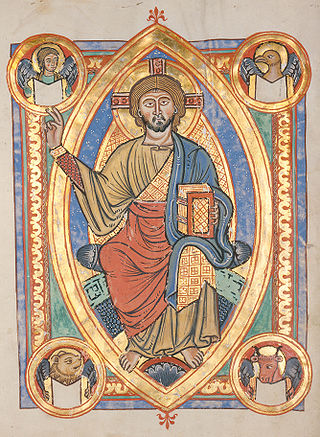
In Catholic tradition, the Five Holy Wounds, also known as the Five Sacred Wounds or the Five Precious Wounds, are the five piercing wounds that Jesus Christ suffered during his crucifixion. The wounds have been the focus of particular devotions, especially in the late Middle Ages, and have often been reflected in church music and art.

Caravaggio's painting of The Incredulity of Saint Thomasc. 1601–1602 was painted for Vincenzo Giustiniani and later entered the Royal Collection of Prussia, survived the Second World War unscathed, and is now in the Palais at Sanssouci, Potsdam, Berlin.

The Supper at Emmaus is a painting by the Italian Baroque master Caravaggio, executed in 1601, and now in London. It depicts the Gospel story of the resurrected Jesus's appearance in Emmaus.

The Elevation of the Cross is the name of two paintings, a very large triptych in oil on panel and a much smaller oil on paper painting. Both pieces were painted by the Flemish artist Peter Paul Rubens in Antwerp, Belgium, the original in 1610 and the latter in 1638. The original is a winged altarpiece, with the outside of the hinged wings also painted. These can be folded over the central panel, giving an 'open view' and a 'closed view'.

The Descent from the Cross is the central panel of a triptych painting by the Baroque artist Peter Paul Rubens in 1612–1614. It is still in its original place, the Cathedral of Our Lady, Antwerp, Belgium. The painting is considered to be one of Rubens' masterpieces. The painting depicts the moment when the body of Jesus Christ is taken down from the cross after his crucifixion. The subject was one Rubens returned to again and again in his career. The artwork was commissioned on September 7, 1611, by the Confraternity of the Arquebusiers, whose patron saint was St. Christopher.
A doubting Thomas is a skeptic who refuses to believe without direct personal experience.
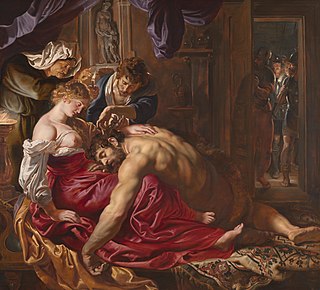
Samson and Delilah is a painting long attributed to the Flemish Baroque artist Peter Paul Rubens (1577–1640) in the National Gallery, London. It dates from about 1609 to 1610.

Theodoor Rombouts was a Flemish painter who is mainly known for his Caravaggesque genre scenes depicting lively dramatic gatherings as well as religiously themed works. He is considered to be the primary and most original representative of Flemish Caravaggism. These Caravaggisti were part of an international movement of European artists who interpreted the work of Caravaggio and the followers of Caravaggio in a personal manner.

The Flagellation of Christ, in art sometimes known as Christ at the Column or the Scourging at the Pillar, is an episode from the Passion of Jesus as presented in the Gospels. As such, it is frequently shown in Christian art, in cycles of the Passion or the larger subject of the Life of Christ. Catholic tradition places the Flagellation on the site of the Church of the Flagellation (the second station of the Via Dolorosa in Jerusalem. It is the second Sorrowful Mystery of the Rosary and the sixth station of the John Paul II's Scriptural Way of the Cross. The column to which Christ is normally shown to be tied, and the rope, scourge, whip or birch are elements in the Arma Christi. The Basilica di Santa Prassede in Rome is one of the churches claiming to possess the original column or parts of it.
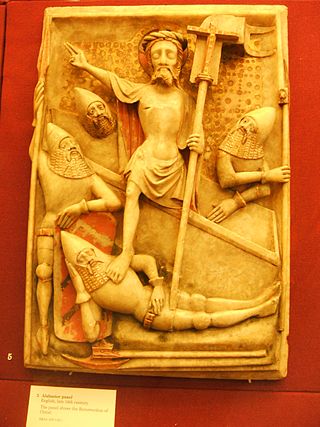
The resurrection of Jesus has long been central to Christian faith and Christian art, whether as a single scene or as part of a cycle of the Life of Christ. In the teachings of the traditional Christian churches, the sacraments derive their saving power from the passion and resurrection of Christ, upon which the salvation of the world entirely depends. The redemptive value of the resurrection has been expressed through Christian art, as well as being expressed in theological writings.

The Twelve Apostles are a common subject in Christian art and serve as a devotional tool for many Christian denominations. They were instrumental in teaching the gospel of Jesus, "continuing the mission of Jesus" with their depictions continuing to serve as spiritual inspiration and authority. Many Protestant denominations reject religious imagery, including the veneration of the apostles and other religious figures.

The Resurrection of Christ is a triptych painting in oil on panel by Peter Paul Rubens, of 1611–1612, that is still in the Cathedral of Our Lady in Antwerp, Belgium. The panels were hinged, with the two wings painted on both sides, by this date a rather old-fashioned format.

The Recollects Convent (Minderbroederskerk) was a monastery of the Recollects order in Antwerp in Belgium. It was the original location of several works by Peter Paul Rubens and Anthony van Dyck (Deposition). It was also the first home of the Royal Museum of Fine Arts until 1875, when the town council decided to rehouse it in a new purpose-built building.

Nicolaas Rockox (1560–1640), was an art patron and collector, numismatist, humanist, philanthropist and mayor of Antwerp. He was a close personal friend and important patron of Peter Paul Rubens. His residence in Antwerp was a centre where Antwerp's humanists and artists congregated and housed a large collection of artworks, antiques, rare objects and coins. It is now a museum known as the Snijders&Rockox House. He was knighted by Archduke Albert and Isabella, the Governor General of the Habsburg Netherlands.

The Incredulity of Saint Thomas is an oil painting on canvas by Matthias Stom, created c. 1640-1649. It is held in the Museo del Prado, in Madrid.
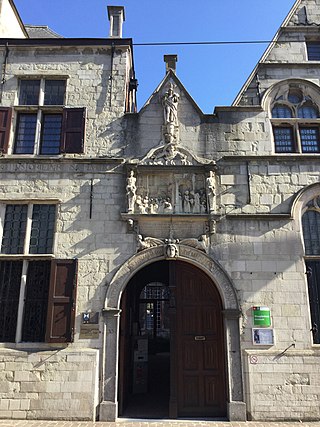
The Maagdenhuis Museum is an art museum and historical museum located in a 17th-century historic building on Lange Gasthuisstraat, Antwerp, Belgium. The building was used as an orphanage for the maegdeckens, or maidens, from the mid-16th century to the end of the 19th century. The museum presents a collection of utensils used daily by the foundlings and the orphans; a collection of antique furniture, and a series of documents relating to the orphanage and the life in it from the 16th century to 19th century.

The Incredulity of Saint Thomas is a tempera painting created by Greek painter Emmanuel Tzanes. Tzanes features a catalog of artwork numbering over one hundred works. He was one of the most prolific artists of the 1600s painting in Crete, Corfu, and Venice. His two brothers Marinos Tzanes and Konstantinos Tzanes were also famous painters but Marinos is more well known for his famous poem The Cretan War Ο Κρητικός Πόλεμος. All three artists were members of the Late Cretan School and early Heptanese School (painting) they were known for participating in the movement that integrated Flemish engravings into the Greek and Italian art world.




